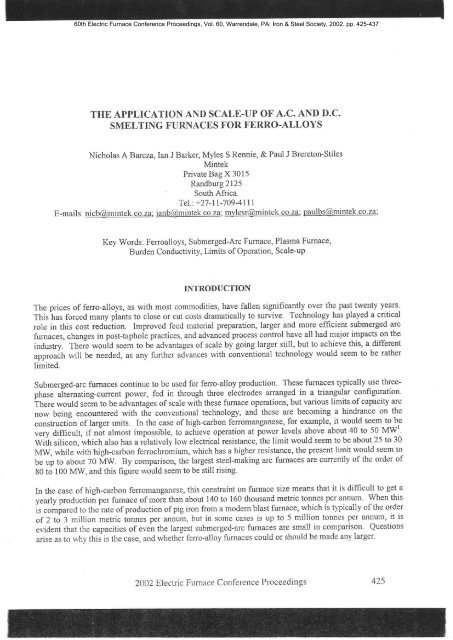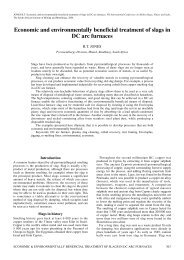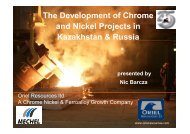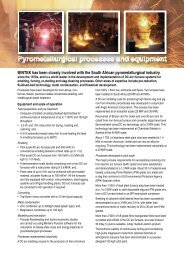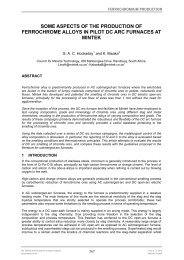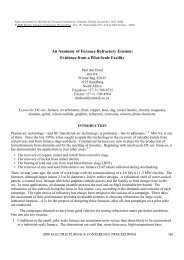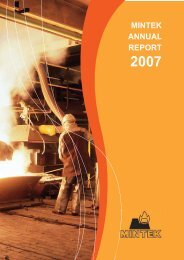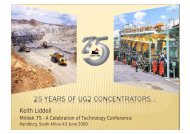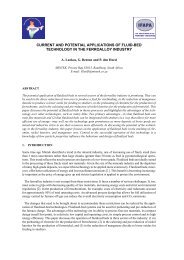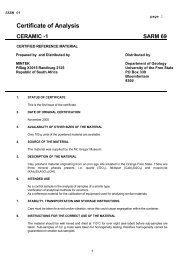the application and scale-up of ac and dc smelting furnaces ... - Mintek
the application and scale-up of ac and dc smelting furnaces ... - Mintek
the application and scale-up of ac and dc smelting furnaces ... - Mintek
Create successful ePaper yourself
Turn your PDF publications into a flip-book with our unique Google optimized e-Paper software.
like a constant-voltage device. In this case, if this voltage is %, <strong>the</strong> followrng equation would relate <strong>the</strong>power to <strong>the</strong> curent:Pr = i.v, (2)Based on <strong>ac</strong>tual data collected from fum<strong>ac</strong>es, Westly proposed <strong>the</strong> C3 f<strong>ac</strong>tor as ano<strong>the</strong>r possible formula todescribe <strong>the</strong> char<strong>ac</strong>teristic curves <strong>of</strong> <strong>the</strong> fum<strong>ac</strong>eo. This relationship can be re-written for a single elechodeas:Ps: its l13"crls1 (3)(It is evident that <strong>the</strong> functional form <strong>of</strong> equation (3) is a compromise between equations (1) <strong>and</strong> (2)).The above three relationships all indicate that:. <strong>the</strong> greater <strong>the</strong> current, <strong>the</strong> greater <strong>the</strong> power, <strong>and</strong>o at a given current, <strong>the</strong> larger ihe magnitude <strong>of</strong> <strong>the</strong> power-dissipating el€ment (i.e. <strong>the</strong> higher <strong>the</strong>resistance, or arc voltage or reciprocal <strong>of</strong> Cj), <strong>the</strong> more power.Accordingly, to raise <strong>the</strong> power dissipation in a fum<strong>ac</strong>e, one should look at ways to both increase <strong>the</strong>current in <strong>the</strong> electrode, <strong>and</strong> ilcrease <strong>the</strong> magnitude <strong>of</strong> <strong>the</strong> power-drssipating element (e.g. <strong>the</strong> resistance)between <strong>the</strong> electrode <strong>and</strong> <strong>the</strong> hearth.Limits on Current per ElectrodeThe dominant f<strong>ac</strong>tor that determines <strong>the</strong> maximum current is <strong>the</strong> diameter <strong>of</strong> <strong>the</strong> electrode. O<strong>the</strong>r f<strong>ac</strong>tors,such as <strong>the</strong> quality <strong>of</strong> <strong>the</strong> paste, <strong>the</strong> design <strong>of</strong> <strong>the</strong> casings, <strong>the</strong> rate <strong>of</strong> slipping, <strong>and</strong> <strong>the</strong> operation <strong>of</strong> <strong>the</strong>fum<strong>ac</strong>e, also have an influence, but are minor by comparison. Hence to increase <strong>the</strong> cimenl-carryingcap<strong>ac</strong>ity, it is basically necessary to increase <strong>the</strong> electrode diameter.Despite all attempts to improve <strong>the</strong> electode technology over <strong>the</strong> years, Andreae's original formula for <strong>the</strong>limrting cunent in a Soderberg electrode is still usedZ. This can be converted to metric units <strong>and</strong> reanangJd,to relate <strong>the</strong> limiting current 1r in kA to <strong>the</strong> diameter <strong>of</strong><strong>the</strong> electrode D6 in metres, as follows:Is = JJ x Puts (4)At present, <strong>the</strong> Iargest sized Soderberg electrodes used in submerged-arc fum<strong>ac</strong>es are tlpically around 1.7 to1.9 metres in diameter. From equation (4), it can be sho*.n that <strong>the</strong>se conespond to current cap<strong>ac</strong>ities <strong>of</strong>aboti 122 to 144 kA respectively. However, it is questionable whe<strong>the</strong>r this formula can still be used topredict <strong>the</strong> cap<strong>ac</strong>ities <strong>of</strong>electrodes that may be larger than about 2.0 metres in diameter, as it has never beentested or verified in this region.The main consequence <strong>of</strong>exceeding <strong>the</strong> current-carrylng cap<strong>ac</strong>rty <strong>of</strong> a given size <strong>of</strong> electrode is that <strong>the</strong> risk<strong>of</strong> an electrode break increases sigrrificantly, although excessive current is not <strong>the</strong> only f<strong>ac</strong>tor that can causean electrode break. If an electrode breaks, not only does it affect <strong>the</strong> production from <strong>the</strong> fum<strong>ac</strong>e, but also itmay <strong>up</strong>set <strong>the</strong> metallurgy <strong>and</strong> so produce <strong>of</strong>f-specificahon material. It would appear that larger electrodesu.r rno." susceptible to breaking. Fur<strong>the</strong>rmore, <strong>the</strong> <strong>up</strong>set to <strong>the</strong> operation may also kigger ano<strong>the</strong>r break,<strong>and</strong> so lead to i vicious cycle <strong>of</strong> electrode breaks that is difficult to recover from, but here <strong>the</strong> inter<strong>ac</strong>tioneffect (as is described in more detail below) probably also plays a role.We suggest that <strong>the</strong>re are fwo direct reasons why a larger Soderberg electrode tends to give more troublethan a smaller one, viz.:1. The strength-to-weight ratio deteriorates as <strong>the</strong> electrode is <strong>scale</strong>d <strong>up</strong>.2. The skin effect distorts <strong>the</strong> distribution <strong>of</strong> <strong>the</strong> current flowing in <strong>the</strong> electrode'2002 Electric Fum<strong>ac</strong>e Conference Proceedings 429
Strength-to-weight ratio - The weight <strong>of</strong> <strong>the</strong> electrode rises by <strong>the</strong> cube <strong>of</strong> a Lineal dimension (e.g. <strong>the</strong>alameter), while <strong>the</strong> strength rises byihe square <strong>of</strong> this dimension That is, <strong>the</strong> strength-to-weight ratio fallsin propoiion to <strong>the</strong> recifrocal <strong>of</strong> <strong>the</strong> dimension as <strong>the</strong> electrode gets larger. Hence. electrodes become.relatively weaker as <strong>the</strong>y get bigger. It would appear that <strong>the</strong>re is no simple solution to this problem'Skin effect - The skin effect refers to <strong>the</strong> tendency <strong>of</strong> a.c. current to keep to <strong>the</strong> outside <strong>of</strong>a conductor' Itdoes not occur with d.c. current. It is caused by voltages induced within <strong>the</strong> conductor by <strong>the</strong> fluctuatingmagnetic field associated with <strong>the</strong> current flowing in <strong>the</strong> same conductor. (This effect should not beconlused with <strong>the</strong> forces on a current-carrying conductor in a magnetic field, as in <strong>the</strong> so-called 'motorrule'). The skin depth is a measure <strong>of</strong> tne depih to which this cunent flow penetrates below <strong>the</strong> surf<strong>ac</strong>e <strong>of</strong><strong>the</strong> conductor. This skin depth d is given by:(5)where p is <strong>the</strong> specific resistivity <strong>of</strong> <strong>the</strong> conductor, /is <strong>the</strong> frequency <strong>of</strong> <strong>the</strong> a.c. current in Hertz, /'{, is <strong>the</strong>-"grr"ii" p"t-.ubitity <strong>of</strong> fiee si<strong>ac</strong>e, <strong>and</strong> p. is <strong>the</strong> relative permeability <strong>of</strong> <strong>the</strong> conductor' By. substitutingtyplcal vaiues for <strong>the</strong>se parameiers, it can be sho$n that for Ssderberg carbon <strong>and</strong> pre-baked carbon, <strong>the</strong>i
way. This is <strong>the</strong> inter<strong>ac</strong>tion effectT. The extent <strong>and</strong> skewness <strong>of</strong> <strong>the</strong> inter<strong>ac</strong>tion effect increases as <strong>the</strong>power f<strong>ac</strong>tor <strong>of</strong><strong>the</strong> fum<strong>ac</strong>e decreases.Soderberg electrodes compound this inter<strong>ac</strong>tion problem, because <strong>the</strong>y cannot be slipped at rvill to recoverlengtlL unlike graphite or pre-baked electrodes. In particular, if an electrode becomes short for whateverreason, <strong>the</strong>n <strong>the</strong> resistance in that phase is likely to be on <strong>the</strong> high side for a period <strong>of</strong> time. This will causenot only <strong>the</strong> current in that electrode to drop, but will also affect <strong>the</strong> currents in <strong>the</strong> o<strong>the</strong>r two electrodes.These o<strong>the</strong>r electrodes will get moved to balance <strong>the</strong>ir currents, <strong>and</strong> in time one will grow longer while <strong>the</strong>o<strong>the</strong>r grou,s shorter. When <strong>the</strong> original short electrode eventually recovers, <strong>the</strong> shorter <strong>of</strong><strong>the</strong> o<strong>the</strong>r trvo maybecome <strong>the</strong> next short electrode, <strong>and</strong> <strong>the</strong> sequence will start again. This chronic electrical imbalance willcreate a highly skewed power distribution inside <strong>the</strong> fum<strong>ac</strong>e, which may affect <strong>the</strong> metallurgical behaviouradversely.A rough guide as to how <strong>the</strong> power f<strong>ac</strong>tor, because <strong>of</strong> <strong>the</strong> inter<strong>ac</strong>tion effect, affects <strong>the</strong> operability <strong>of</strong> afurn<strong>ac</strong>e with Soderberg elechodes is as follows:cos p:0.8 to 1.0: <strong>the</strong> inter<strong>ac</strong>tion effect can be observed, but is not a major problem,cos p : 0.65 to 0.8: <strong>the</strong> effect is significant enough to be an occasional problem,cos p : 0.5 to 0.65: <strong>the</strong> effect is likely to be a continual operational problem,cos p:
DISCUSSIONIt would seem from <strong>the</strong> above analysis that <strong>the</strong> main f<strong>ac</strong>tor that constrains <strong>the</strong> sizes <strong>of</strong> present a.c.submerged-arc ferro-alloy fum<strong>ac</strong>es is <strong>the</strong> inductive re<strong>ac</strong>tance caused by <strong>the</strong> magletic fields around (mainly)<strong>the</strong> electrodes in <strong>the</strong> fum<strong>ac</strong>e. The main consequence <strong>of</strong> inductive re<strong>ac</strong>tance would seem to be <strong>the</strong>inter<strong>ac</strong>tion effect. A second consequence is <strong>the</strong> larger transformer required. Both <strong>the</strong>se consequencesbecome more severe as <strong>the</strong> power f<strong>ac</strong>tor decreases <strong>and</strong> <strong>the</strong>y <strong>the</strong>refore become more problematical as <strong>the</strong> size<strong>of</strong> <strong>the</strong> fum<strong>ac</strong>e increases.The Soderberg electrodes in larger furn<strong>ac</strong>es also seem to be troublesome, but it is not clear whe<strong>the</strong>r this isprimarily because <strong>of</strong> an inherent fragility <strong>of</strong> <strong>the</strong> larger electrodes, or because <strong>of</strong> <strong>the</strong> inter<strong>ac</strong>tion effect, orbecause <strong>of</strong> <strong>the</strong> skin effect. Operation in <strong>dc</strong>. mode would alleviate <strong>the</strong> inter<strong>ac</strong>tion effect <strong>and</strong> <strong>the</strong> skin effect,but not <strong>the</strong> inherent electrode fragility.With most existing submerged-arc prqcesses, <strong>the</strong>re is little that can be done about significantly increasing<strong>the</strong> resistance <strong>of</strong><strong>the</strong> burden. However, as in t.he case <strong>of</strong> ferrochromium, it may be possible to change to afully open-arc or a mked mode <strong>of</strong> operation, <strong>the</strong>reby increasing <strong>the</strong> resistance (<strong>and</strong> <strong>the</strong>refore <strong>the</strong> voltage)significantly. ln <strong>the</strong> case <strong>of</strong> ferromanganese alloys, <strong>the</strong> high vapour pressure <strong>of</strong> manganese at <strong>the</strong> normalfum<strong>ac</strong>e temperatures will limit <strong>the</strong> degree <strong>of</strong> arc power without incurring significant metal losses. WitIsilicon, <strong>and</strong> ferrosilicon, <strong>the</strong> re<strong>ac</strong>tion b€tween silicon monoxide <strong>and</strong> carbon requires <strong>the</strong> presence <strong>of</strong> a solidpermeable burden above <strong>the</strong> re<strong>ac</strong>tion zone around <strong>the</strong> arc. Sigaificantly longer a.c. arcs <strong>the</strong>refore seem to beundesirable in <strong>the</strong> silicon process. On <strong>the</strong> o<strong>the</strong>r h<strong>and</strong>, with ferronickel, <strong>the</strong> normal mode <strong>of</strong> operation issemlopen, <strong>and</strong> thus very high voltages are tle norm. To *hat degee <strong>the</strong> use <strong>of</strong>d.c. power for open-arc <strong>and</strong>semi-open-arc operation will benefit <strong>the</strong>se o<strong>the</strong>r processes has possibly not been fully evaluated.With <strong>the</strong> corect pre-treatment <strong>of</strong> <strong>the</strong> feed materials, <strong>the</strong> permeability <strong>of</strong> <strong>the</strong> burden may not be such <strong>ac</strong>onstraint at higher power levels, but <strong>the</strong> fum<strong>ac</strong>e infrastructure will need to be able to h<strong>and</strong>le <strong>the</strong> occasionalhot "blow''.it is evident from tlre above arguments that d.c. operation could provide a way to increase <strong>the</strong> size <strong>of</strong>fum<strong>ac</strong>es sigmficantly beyond what is currently attainable with a.c. furn<strong>ac</strong>es. Fur<strong>the</strong>rmore, it is notinconceivable that, with <strong>the</strong> use <strong>of</strong> multiple-el€ctrode d.c. technology, ferro-alloy fum<strong>ac</strong>es <strong>of</strong> well above100 MW could be built <strong>and</strong> successfully operated.The use <strong>of</strong> graphite or pre-baked electrodes may also help to overcome some <strong>of</strong> <strong>the</strong> problems inherent inlarge Soderberg electrodes, as <strong>the</strong>y do not require <strong>the</strong> same level <strong>of</strong> care in <strong>the</strong>ir operation, <strong>and</strong> in particularlhey do not ha\ e to be slipped evenly <strong>and</strong> regularly.From <strong>the</strong> vie*'point <strong>of</strong> <strong>the</strong> electricity s<strong>up</strong>ply grid, existing a.c. submerged-arc fum<strong>ac</strong>es do not impose anymajor problems, apart from low porver f<strong>ac</strong>tors, *'hich can in any case be corrected by cap<strong>ac</strong>itors should <strong>the</strong>need arise. Flicker is not normally a problem with submerged-arc furn<strong>ac</strong>es, udike <strong>the</strong>ir open-arc relatives.Fur<strong>the</strong>rmore, <strong>the</strong> technology for delivering a.c. power to a fum<strong>ac</strong>e is relatively basic, well established, <strong>and</strong>trouble free. The d.c. fum<strong>ac</strong>e, ho1ever, is not so simple. The tlpes <strong>of</strong> problems created dep€nd on <strong>the</strong> tlpe<strong>of</strong> porver s<strong>up</strong>ply. Thlristor bridge s<strong>up</strong>plies generate severe harmonics in <strong>the</strong> waveform <strong>of</strong> <strong>the</strong> current drawnflom <strong>the</strong> mains, <strong>and</strong> because <strong>of</strong>this, considerable effort has been required in <strong>the</strong> development <strong>of</strong> <strong>ac</strong>tive <strong>and</strong>passive compensation circuits. The best solution for minimising <strong>the</strong> disturbance to <strong>the</strong> mains is <strong>the</strong> use <strong>of</strong>aihopper s<strong>up</strong>ply, also called a pulse-width modulation (PWM) s<strong>up</strong>ply, which <strong>of</strong>ten uses insulated-gatebipolar transistors (IGBTs). However, tlis tlpe <strong>of</strong> power s<strong>up</strong>ply is relatively bulky, complex, expensive,<strong>and</strong> its reliability has yet to be proven.It is also not knox.n to what extent problems would be created by <strong>the</strong> electrical load <strong>of</strong> a very large ferroalloyfum<strong>ac</strong>e on <strong>the</strong> electricity s<strong>up</strong>ply gnd, e.g. by simply s*'itching on or <strong>of</strong>f Could <strong>the</strong>re be any fansientinstability problems, <strong>and</strong> would <strong>the</strong> s<strong>up</strong>ply authority tolerate such loads?2002 Electric Fum<strong>ac</strong>e Conference Proceedings 435
The production from very large furn<strong>ac</strong>es relative to <strong>the</strong> total world production may become an issue if <strong>the</strong>fum<strong>ac</strong>es are built significantly larger. ln <strong>the</strong> case <strong>of</strong> high-carbon ferrochromium for example, <strong>the</strong> existinglargest fum<strong>ac</strong>es can e<strong>ac</strong>h produce about 2o/o <strong>of</strong> <strong>the</strong> total world production. For larger furn<strong>ac</strong>es still, <strong>the</strong>percentage would be proporlionately higher.At <strong>the</strong> peak <strong>of</strong> <strong>the</strong> char<strong>ac</strong>teristic curve in Fig. 2, <strong>the</strong> power f<strong>ac</strong>tor is 0.7, while to <strong>the</strong> left <strong>of</strong> <strong>the</strong> peak <strong>the</strong>power f<strong>ac</strong>tor is higlrer <strong>and</strong> to <strong>the</strong> right it is lower. Hence operation to <strong>the</strong> right <strong>of</strong> <strong>the</strong> peak <strong>of</strong> <strong>the</strong>thar<strong>ac</strong>teristic cuwe is associated with large fum<strong>ac</strong>es <strong>and</strong> with operational problems. Fig. 6 shows anapproximate line <strong>of</strong> constant power f<strong>ac</strong>tor, s<strong>up</strong>erimposed on <strong>the</strong> trend lines fiom Fig. 3. This lineconesponds to a cos g <strong>of</strong> about 0.7 at 50 tIz- To <strong>the</strong> left <strong>of</strong> this line, <strong>the</strong> power f<strong>ac</strong>tor is higher than 0.7,while to <strong>the</strong> right it is lower. That is, this line forms <strong>the</strong> approximate boundary between <strong>the</strong> problematicoperating region to <strong>the</strong> right, <strong>and</strong> <strong>the</strong> more stable region to <strong>the</strong> left. This figure shows that, in general, <strong>the</strong>trinds <strong>of</strong> all <strong>the</strong> processes are aiming towards <strong>the</strong> more problematic region <strong>of</strong> operation. However, <strong>the</strong>ferrosilicomanganese process is already well into this region, while <strong>the</strong> ferrochromium process still hassome way to go.= ooFecr in higharc inodeEFElectrode current, kAFig. 6. A line <strong>of</strong>constant power f<strong>ac</strong>tor, s<strong>up</strong>erimposed on <strong>the</strong> trend lines <strong>of</strong>Fig. 3, to indicate <strong>the</strong>approximate boundary <strong>of</strong><strong>the</strong> problematic region <strong>of</strong>operation in a.c. fum<strong>ac</strong>es120CONCLUSIONSConventional submerged-arc fum<strong>ac</strong>es that use a.c. mains power directly would seem to have re<strong>ac</strong>hed or areclose to a limit in size. This limit is caused primarily by <strong>the</strong> low resistance compared to <strong>the</strong> re<strong>ac</strong>tance in <strong>the</strong>fum<strong>ac</strong>e, which leads to low power f<strong>ac</strong>tors, <strong>and</strong> this incurs operational problems that are severe enough todiscourage <strong>the</strong> installation <strong>of</strong> large fum<strong>ac</strong>es. There may also be a separate problem rvith self-bakingSoderberg electrodes as <strong>the</strong>y get larger, which also discourages <strong>the</strong> installation <strong>of</strong> larger fum<strong>ac</strong>es. Prebake<strong>dc</strong>arbon or graphite electrodes *'ould overcome most <strong>of</strong><strong>the</strong> problems with Soderberg electrodes.In recant ).ears, power s<strong>up</strong>plies have become available that can deliver d.c. power at very high crmentsFrom <strong>the</strong> point <strong>of</strong> view <strong>of</strong> <strong>the</strong> fum<strong>ac</strong>e operation, d.c. obviates <strong>the</strong> problems <strong>of</strong> re<strong>ac</strong>tance. There is also apossibilitythat d.c. may lessen <strong>the</strong> problems with large Soderberg electrodes, but this remains to be proven436 2002 Electric Fum<strong>ac</strong>e Conference Proceedings
While d.c. operation would seem to have relaxed some <strong>of</strong><strong>the</strong> limits on conventional fum<strong>ac</strong>es, <strong>the</strong>re are stilla number <strong>of</strong>questions that are unanswered, such as:. To what extent does d.c. operation affect <strong>the</strong> mechanisms <strong>and</strong> alter <strong>the</strong> metallurgy <strong>of</strong> existing t)?es<strong>of</strong> feno-alloy production processes?. AJe <strong>the</strong>re any restrictions on <strong>the</strong> currents that can be carried via a comection to <strong>the</strong> hearth?. How reliable is a very large d.c. power s<strong>up</strong>ply likely to be?. Very large furn<strong>ac</strong>es would constitute a significant load on <strong>the</strong> electricity grid. Would this presentany problems for <strong>the</strong> stability <strong>and</strong> control <strong>of</strong> <strong>the</strong> grid? Would power s<strong>up</strong>ply authorities tolerate suchlarge unit loads?o Are <strong>the</strong>re any extemal constraints on <strong>the</strong> sizes <strong>of</strong> feno-alloy fum<strong>ac</strong>es, such as marketing <strong>and</strong>distribution <strong>of</strong> <strong>the</strong> products?. Hot blowholes though <strong>the</strong> burden in <strong>the</strong> fum<strong>ac</strong>e may become an issue with sigtificantly largerfum<strong>ac</strong>es, necessitating greater attention to <strong>the</strong> control <strong>of</strong><strong>the</strong> size char<strong>ac</strong>teristics <strong>of</strong> feed materials.SummaryThis paper examines <strong>the</strong> tecbnical issues thal cunently constrain large-sized ferro-alloy fum<strong>ac</strong>es. ThepossiUitity <strong>of</strong> fur<strong>the</strong>r <strong>scale</strong>-<strong>up</strong> is also studied, <strong>and</strong> e<strong>ac</strong>h <strong>of</strong><strong>the</strong> various constraints is investigated with a viewio horv ii might be eased oi even circumvented. It would appear that d.c. power may <strong>of</strong>fer some criticaladvantages ii this regard, <strong>and</strong> may even help to relieve some <strong>of</strong> <strong>the</strong> problems that existing large fum<strong>ac</strong>esdisplay.Ackn owledgemenlsThis paper is published by permission <strong>of</strong> <strong>Mintek</strong>ReferencesL N A Barcza, "Recent Technical Developments <strong>and</strong> Future Trends in <strong>the</strong> Sou<strong>the</strong>m African Feno AlloyIndustry', Mebl Bulletin Ferro Allov Conference, February 2002, Sun City, South Africa.2. F. V. Andreae, "Design <strong>and</strong> Control <strong>of</strong>Ferro-Alloy Fum<strong>ac</strong>es", AIEE Trans<strong>ac</strong>tions. Vol. 69, i950, pp. 557-562-3. W. M. Kelty, "Design aad Consfiuction <strong>of</strong> <strong>the</strong> Submerged Arc Furn<strong>ac</strong>e", Carbol <strong>and</strong> Graphite News. Vol. 5' No1, AprllMay 1958.4. J. Westlv. 'Dimension des fours de reduction pour Fe-Si et d'autr€s Ferro-alliages", Journal du Four Electrique.No. 1, January 1979,PP.14-19.5. A. L. Moolman, Ir,l.-S. Rerurie, P. Brereton-Stiles, "Advanced Power Control Strategy for Submerged-ArcFum<strong>ac</strong>es"Canada The Ferroalloys Assoc., Washingloo, DC, USA June 2001, pp 103-i07'6. .q.. dewaal, I. J. Ba*er, tr,t. S. nennii, J. Kopper, B. S. Groenevel4 "Electrical affecting <strong>the</strong>-f<strong>ac</strong>tors *Proceedi{rss <strong>of</strong> <strong>the</strong> 6'Intemationaleconomic optimisation <strong>of</strong> submerged-arc fumails", INFACON 6 -Fenoallols 'Conference. Cape Town. Vol. 1. Johannesburg, SAIMIT{, 1992,pp247-2527 I J Bu.ker. A B St"*art, "ktdoctiv" re<strong>ac</strong>tance, <strong>and</strong> <strong>the</strong> operation <strong>of</strong> large submerged-arc fum<strong>ac</strong>es"' I-LAfr. Inst. Min & Metall., Vol. 80, No 3, March 1980, pp. 123-128'2002 Electric Furn<strong>ac</strong>e Conference Proceedings 437
60thELECTRIC FURNACECONFERENCE PROCEEDINGSNovember l0 - 13,2002San Antonio, TexasSponsored by <strong>the</strong>Electric Fum<strong>ac</strong>e Division<strong>of</strong><strong>the</strong>Iron & Steel SocietyDavid L. KanagyPublisherMargaret A. BakerEditoa Book Publishing
The Iron & Steel Societyis not responsible for statements or opinionsexpressed in this publication.60th Electric Fum<strong>ac</strong>e Conference Proceedings, Vol. 60These proceedings are also available in CD-ROM format.Copyright @ 2002Iron & Steel SocietyAll rights reservedPrinted in <strong>the</strong> U.S.A.ISBN: 1-886362-63-7ISSN:0096-0128ISS Publications...Ktowledge fulfillment with a commitment to <strong>the</strong>quality, ifiegrtty <strong>and</strong> timeliness <strong>of</strong> information transfenIron & Steel Society186 Thom Hill RoadWarrendale, PA 15086-7528Phone: Q24)776-1535Fax:. (724)776-0430E-mail: custserv@iss.orgWeb site: www.iss.orgPublication s<strong>up</strong>ported by <strong>the</strong> Seeley W. Mudd Memorial Fund <strong>of</strong> AIIT4E


